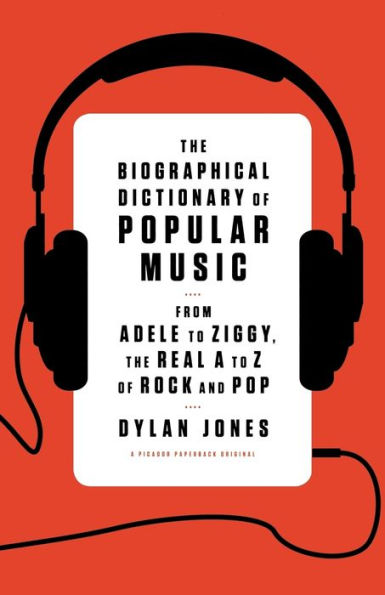
The Biographical Dictionary of Popular Music: From Adele to Ziggy, the Real A to Z of Rock and Pop
912
The Biographical Dictionary of Popular Music: From Adele to Ziggy, the Real A to Z of Rock and Pop
912Paperback
-
PICK UP IN STORECheck Availability at Nearby Stores
Available within 2 business hours
Related collections and offers
Overview
The Biographical Dictionary of Popular Music is an incredible and opinionated collection of celebrated cultural critic Dylan Jones's thoughts on more than 350 of the most important artists around the world—alive and dead, big and small, at length and in brief. This A to Z reference is the true musical heir to David Thomson's seminal The New Biographical Dictionary of Popular Film. Jones writes entertainingly about bands that have inspired, bedeviled, and fascinated him over the years.

Product Details
| ISBN-13: | 9781250031860 |
|---|---|
| Publisher: | Picador |
| Publication date: | 10/30/2012 |
| Pages: | 912 |
| Sales rank: | 1,140,565 |
| Product dimensions: | 5.30(w) x 8.20(h) x 1.80(d) |
About the Author
DYLAN JONES is the editor in chief of British GQ, where he has won the BSME Editor of the Year Award seven times during his tenure and was recognized for the Innovation/Brand-Building Initiative of the Year award for the annual GQ Men of the Year Awards. Jones has a weekly column in The Mail on Sunday's magazine supplement and writes regularly for The Spectator. His other works include Jim Morrison: Dark Star; Paul Smith: True Brit; and iPod, Therefore I Am.
Read an Excerpt
THE BIOGRAPHICAL DICTIONARY OF POPULAR MUSIC
A TRIBE CALLED QUEST
As the foundation of Lou Reed’s “Walk On The Wild Side” glides across the stereo, a loop that immediately sounds as though it should come with its very own Lava Lamp, we hear Q-Tip and Phife Dawg shuffle into the picture, gibbering away as though they were in The Goon Show. And suddenly – as if from nowhere – “Can I Kick It?” is in full view. A Tribe Called Quest’s jazz-rap fusions can still play all night, moving from hotel lobby to shebeen to the iPad with ease, and you can dip in and out of their tunes without any great shock to the system. With laid back loops involving Cannonball Adderley, Roy Ayres, the Average White Band, and the Rotary Connection, unperturbing dynamics and the kind of restrained vocals usually associated with the coffee house, ATCQ invented a new kind of hip-hop, a decade after the first kind.
“Nothing was touching Tribe, nothing,” said Pharell Williams of these exponents of jazz-hop fusion, and for a while he was right. There was no boasting with Tribe, and as one critic succinctly put it, they “heralded the advent of a generation of intellectual, philosophical, sociological rappers that investigated the condition of the African-American soul rather than the street epics of gangsters.” Didn’t they just.
Hip-hop had embarked on a lexical inflation game in which each particular sub-genre of gangster rap had to be bigger, badder and more aggressive than the one before, whereas ATCQ were content to roll everything back, turn down the volume and allow things to take their natural course. Perhaps assuming there were many who thought rap was morally and culturally non-nutrient, Tribe created a bouillabaisse that was rich in content, rich in diversity, and diverse in delivery.
Out of Queens they came, all goatees and whispers, a central part of the Native Tongues Posse (a collective that also included De La Soul), surfing a wave of fresh alt hip-hop, determined to mix it up, elegantly fusing rap with jazz and getting justly rich in the process. Q-Tip, Phife Dawg, Ali Shaheed Muhammad, and Jarobi White launched themselves in 1985, and in their first incarnation lasted until 1998. Their first album, People’s Instinctive Travels & The Paths Of Rhythm, was similar to De La Soul’s Three Feet High And Rising in that it celebrated its own eclecticism, not just musically, but lyrically, too, referencing safe sex and vegetarianism, and appearing unembarrassed about having a sense of humour – not something you find often with gangster rap. One reviewer said that record was, “So sweet and lyrical, so user-friendly, you could play it in the background when you’re reading Proust.” This was hip-hop moving from the foreground to the background, from upstage to downstage, from the dancehall to the gallery. With People’s Instinctive Travels & The Paths Of Rhythm, hip-hop crossed the Rubicon of enforced recognition – you no longer had to pay attention to it, you could just listen to it passively. Hip-hop had left the classroom.
As you can see in the award-winning documentary Beats Rhymes & Life: The Travels Of A Tribe Called Quest (which kick-started its critical victory lap by winning the Audience Award for Best Documentary Feature at the Los Angeles Film Festival), ATCQ fell apart acrimoniously, rather unnecessarily soiling their reputation as one of the most important founding fathers of modern hip-hop.
The iTunes algorithms seem to have produced the right rankings here, and they click with my personal choices: “Can You Kick It?” (obviously, predictably), “Bonita Applebum” from People’s Instinctive Travels & The Paths Of Rhythm, and “Electric Relaxation” from Midnight Marauders.
They have their detractors, too. “ATCQ?” said a friend of mine, when asked. “Like yoga, Starbucks, Banksy, camping, political prisoners, hummus, and Facebook – they’re just more stuff white people like.”
THE BIOGRAPHICAL DICTIONARY OF POPULAR MUSIC. Copyright © 2012 by Dylan Jones
